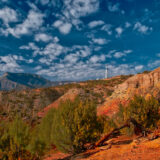A raccoon’s long-toed footprint adorned the muddy lakeshore. A killdeer screeched overhead and a fluffy-tailed coyote loped through nearby grasslands. Yet the animal that wildlife biologist Wendy Hanophy sought on a hot October day remained elusive.
The northern leopard frogs she was searching for were likely bedded down in wetlands surrounding the Aurora Reservoir to protect their moist skin from the midday heat. The amphibian’s absence underscored the stakes: Scientists agree the indicator species, which is difficult to spot, count and monitor, is particularly at risk from habitat disturbances.
Hanophy and hundreds of Aurora residents are hoping the imperiled vertebrate will help them persuade state regulators to deny a request by Crestone Peak Resources Operating LLC to build one of Colorado’s largest oil and gas pads on a former bombing range less than a mile from the reservoir and their homes in the Denver suburbs.
“Frogs will disperse up to three miles as soon as they’ve bred and hatched,” said Hanophy, a retired Colorado Parks and Wildlife employee, as dry grass crunched under her hiking boots. “They have to eat, and they don’t stay in the reservoir for that. They are foraging all up and around these areas.”
Indeed, several weeks before Hanophy’s fruitless search, herpetologists hired by a residents’ group found three northern leopard frogs uphill from where she stood close to the proposed 35-acre oil and gas site. The discovery came after state officials listed “Oil & Gas Exploration & Extraction” as a threat to the species in a 2025 wildlife action plan. The document categorized the amphibian as requiring “conservation interventions most urgently.”
The dwindling numbers of leopard frogs also prompted the U.S. Fish and Wildlife Service to participate in an ongoing case study to restore habitat for the amphibian in an area northwest of Denver. Early findings noted that the four-inch-long vertebrate is “identified as a species of greatest conservation need in many western states” and is “considered sensitive, threatened, or endangered.”
The proposed 32-well State Sunlight/Long pad is one of several oil and gas sites slated for what is now known as the Lowry Ranch. Situated about 25 miles southeast of downtown Denver, the picturesque property is surrounded by fast-growing suburbs. The State Land Board, which owns and manages the 26,000-acre ranch, echoed Fish and Wildlife’s conclusion that the frogs need undisturbed habitat in a “2050 Stewardship Framework.”
The planning document found the ranch’s Piedmont grasslands support “several species of conservation concern that require habitat components that are unique and rare.” The land board signed a lease with Crestone’s parent company, Civitas Resources, that allows it to drill on the property. State regulators are charged with approving the locations of the wells.
There is precedent for imperiled species like the northern leopard frog slowing down, changing the design, or even shutting down industrial projects altogether. The Braken Bat Cave meshweaver spider stopped construction on a San Antonio highway. In West Virginia, the Indiana bat stalled progress on a multimillion-dollar wind farm. The endangered snuffbox mussel halted work on a bridge over the Grand River in Ohio. And in California, the delta smelt prevented an effort by the first Trump administration to make “improvements” to the state’s water infrastructure.
Northern leopard frogs are known to frequent the area where the Sunlight/Long pad is proposed. Surveys conducted by consultants hired by Crestone found the amphibians near the site over the last decade, according to a summary the energy company filed with state regulators prior to a highly anticipated Nov. 19 hearing on the proposed pad.
The vertebrates were found in creek beds near the proposed project site in surveys conducted from 2012 to 2015 and again in 2018, according to the summary. After additional surveys in 2024 and this year, consultants concluded the amphibians may spend winter in nearby creek beds.
Researchers hired by a 2,400-member residents group known as Save the Aurora Reservoir, or STAR — who observed three frogs in the area this fall — said in a Sept. 22 report that repeated sightings “seems to indicate a stable population at this site.”
“This site is likely part of a larger, and not fully researched, metapopulation for northern leopard frogs which may connect this population to other breeding populations” nearby, wrote researchers with Adaptation LLC, the company retained by residents to conduct the survey.
To protect this population, state wildlife officials suggested in a Sept. 30 letter to the state’s Energy & Carbon Management Commission that an alternative location for the massive oil and gas pad would better protect the frog because it would keep more of its habitat intact.
Even so, Colorado Parks and Wildlife biologist Brandon Marette acknowledged in the letter to commission director Julie Murphy that such an alternative is not feasible because it doesn’t comply with Arapahoe County rules that oil and gas operations be situated at least 3,000 feet from reservoirs.
Marette also wrote that “the western U.S. population of [northern leopard frogs] is declining” and that in the region where the pad is proposed these groups are “fragmented and limited and existing threats are likely to significantly increase in scope and/or severity within ten years.”
Because of this, he suggested mitigation measures designed to divert frogs away from an access road slated to handle scores of truck trips a day from the proposed oil and gas pad. The byway will sit just 500 feet from the reservoir, leading to concerns about frog “mortalities resulting from truck and vehicle traffic,” he added.
The biologist asked state regulators to require the energy firm to construct the pad and make improvements to the road between Dec. 1 and Feb. 28 when the frogs are hibernating. Colorado Parks and Wildlife also requested the company conduct “windshield surveys” to “document any (frog) mortalities on the road” at least once a week between March and November when the amphibians are active. Crestone’s consultants must report any deceased frogs to Parks and Wildlife.
The frog’s prominent role in the Nov. 19 hearing on the Sunlight/Long pad is underscored in a recommendation by Murphy, the Energy & Carbon Management Commission director, to the five-member commission that it approve the oil and gas project. The amphibian is referenced 90 times in her 265-page report.
Murphy wrote that Crestone agreed to time construction on the pad to coincide with the frog’s hibernation period, to survey for frogs prior to disturbing the land and to build silt fences that guide amphibians to culverts that cross under the road.
Crestone acknowledged concern about the frogs in a prehearing statement filed with state regulators in advance of the Nov. 19 hearing. The company gave a nod to the Adaptation report in the prehearing statement, noting wildlife officials incorporated “aspects” of its findings into mitigation measures that the company agreed to.
“The [Parks and Wildlife] consultation letter speaks for itself on the issue of Crestone’s extensive protection of wildlife resources and should be relied upon by the commission,” wrote Jamie Jost, an attorney representing Crestone before the commission.
Habitat disturbance is already underway on other parts of the Lowry Ranch. State energy regulators earlier this year approved several multiwell pads included in a 50-square-mile comprehensive area plan drilling plan. The development could include up to 166 wells at eight locations to be constructed through 2030.
Residents in neighborhoods ringing the ranch’s southern edge organized STAR to protest drilling near their communities when Crestone initially submitted the plan to state regulators in 2022.
The group’s concerns about pollution, earthquakes, noise and traffic drew nationwide scrutiny to a 2019 mission change that requires Colorado’s energy agency to prioritize health, safety and the environment over fossil fuel company profits. State officials promulgated 426 pages of rules — during 17 rulemaking periods — to implement this change.
STAR’s activism changed the way the five-member energy commission considers neighborhood concerns. Its members filed thousands of comments opposing the Sunlight/Long pad.
The outcry prompted the commission to hold a rare public hearing in the community in September. STAR, represented by an attorney, also became the first residents’ organization to appear in front of the commission at a hearing in 2024 and will again testify on Nov. 19.
The nonprofit continues to test the boundaries of the state’s new oil and gas rules in its prehearing statements by challenging how Crestone complied with requirements that companies devise wildlife protection plans for new and amended locations.
“Wildlife resources are to be protected to the same extent as people and the environment,” wrote STAR’s attorney, Mike Foote. “Neither Crestone’s wildlife mitigation plan, nor (Parks and Wildlife’s) consultation report gave any serious consideration to placing Sunlight Long in a location that could avoid adverse impacts to the (frogs) in the first place.”
Even with mitigation measures agreed to by Crestone and state wildlife and oil and gas officials in advance of the hearing, Hanophy, the retired biologist, remains concerned that pollution, noise and vibrations that she says could disrupt breeding; land disturbance; and traffic will prove fatal for the amphibians.
“If they can’t get from point A to point B, that’s one population that could crash,” said the STAR wildlife adviser as she stood on a bike path that encircles the Aurora Reservoir.
“Extinction usually isn’t immediate — it happens slowly, and then quickly, and you get to a point where a population can’t take care of itself.”
Copyright 2025 Capital & Main


 Pain & ProfitNovember 3, 2025
Pain & ProfitNovember 3, 2025
 Column - State of InequalityOctober 16, 2025
Column - State of InequalityOctober 16, 2025
 The SlickOctober 17, 2025
The SlickOctober 17, 2025
 Latest NewsOctober 29, 2025
Latest NewsOctober 29, 2025
 Latest NewsOctober 20, 2025
Latest NewsOctober 20, 2025
 Column - State of InequalityNovember 6, 2025
Column - State of InequalityNovember 6, 2025
 Latest NewsOctober 22, 2025
Latest NewsOctober 22, 2025
 Column - State of InequalityOctober 23, 2025
Column - State of InequalityOctober 23, 2025

